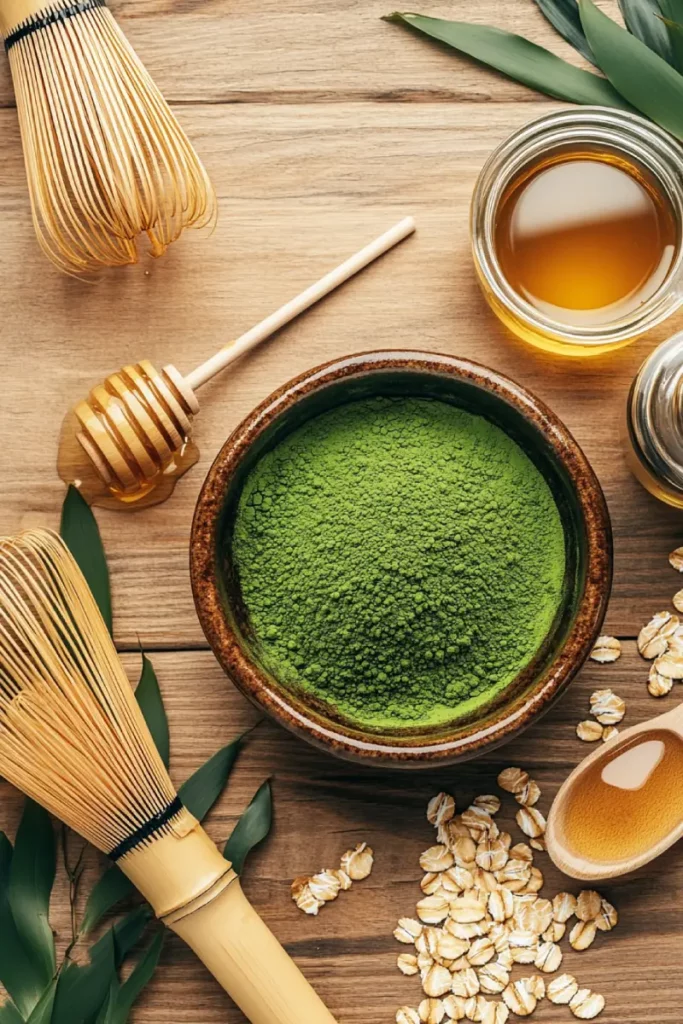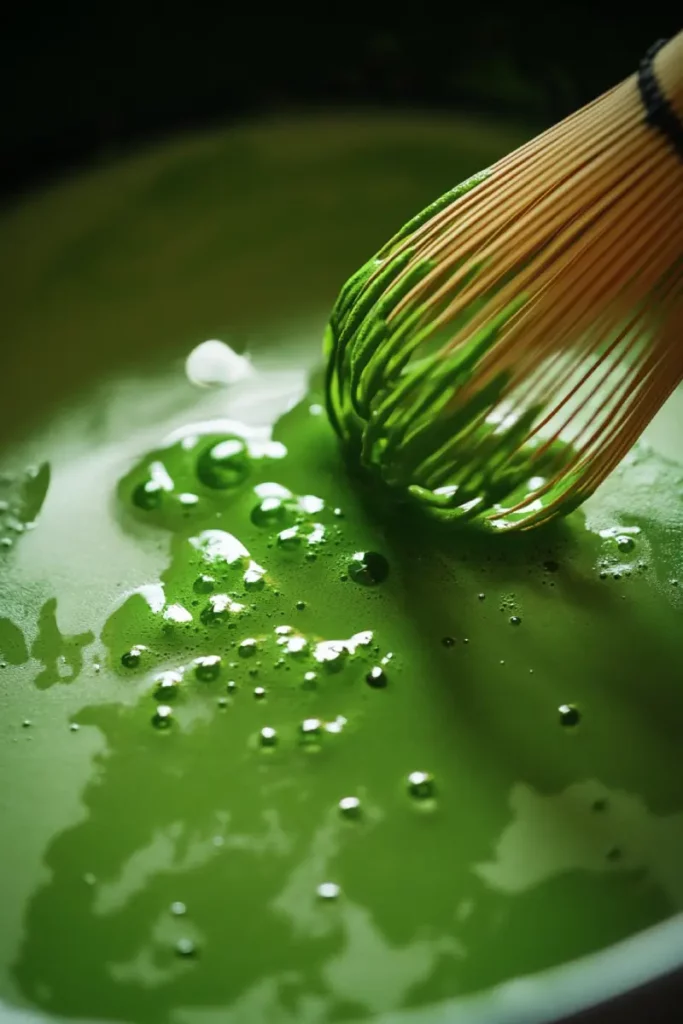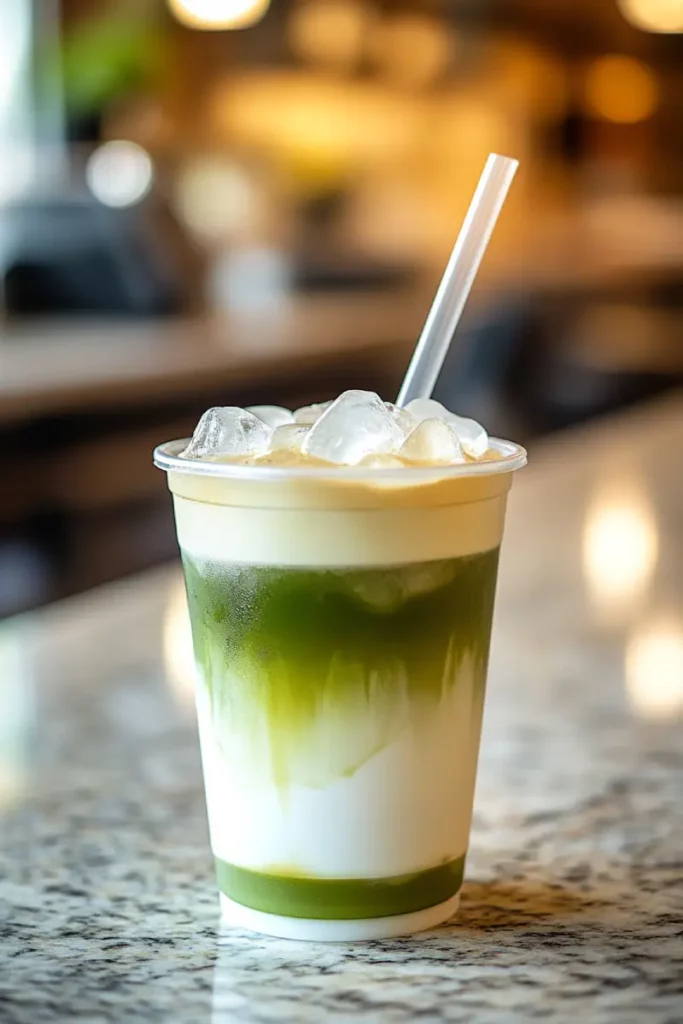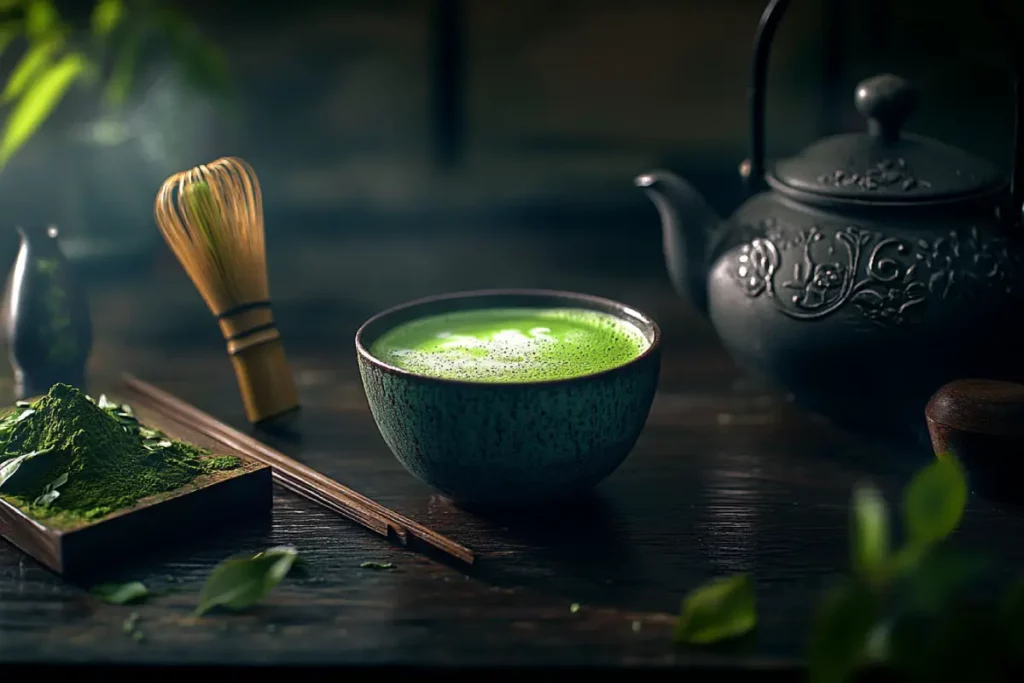Matcha tea has become a staple for wellness enthusiasts, fitness lovers, and coffee alternatives seekers across the U.S. With its vibrant green hue and bold earthy flavor, matcha tea isn’t just trendy—it’s deeply rooted in centuries of tradition. Whether you sip it for energy, metabolism, or mindfulness, matcha tea is packed with benefits that make it stand out in today’s health scene.
In this article, you’ll learn exactly what matcha tea does to your body, whether it’s safe to drink every day, and how it compares to green tea. We’ll also cover matcha recipes, potential side effects, and where to buy the highest-quality matcha powder. Plus, we’ve linked helpful resources like our Matcha White Chocolate Mochi Cake Recipe and Natural Mounjaro Recipe Tea to help you enjoy matcha drink in creative ways.
Let’s start with how matcha tea became the superstar of daily drinks.
Why Matcha Tea Has Become a Daily Favorite in America
Matcha Tea: A Modern Ritual Backed by Centuries
The rise of matcha in the U.S. isn’t random—it’s the result of growing awareness about natural energy, antioxidants, and brain-boosting ingredients. Originally part of traditional Japanese tea ceremonies, matcha drink dates back to the 12th century. It was brought from China by Buddhist monks and soon adopted by samurai warriors for its calm alertness effect. Today, it’s making waves in health cafes, fitness studios, and home kitchens.
Unlike regular green tea, matcha uses whole powdered leaves, meaning you consume all the nutrients. One cup delivers more antioxidants than 10 cups of regular brewed green tea. That’s one reason this tea has become the preferred choice for those who want results without the crash of coffee.
The ritual of preparing matcha—whisking, sipping, pausing—adds to its appeal. In a culture driven by speed,this matcha offers a moment of intention and calm with every cup.
Understanding the Japanese Origins of Matcha Powder
Matcha tea is more than just a beverage—it’s an art form in Japan. Grown primarily in the Uji and Nishio regions, the finest matcha comes from carefully shaded green tea leaves. This shading boosts chlorophyll and amino acid levels, giving matcha its iconic color and rich flavor.
Ceremonial-grade matcha, the highest quality, is ground using traditional stone mills. It has a smoother taste and is typically used for sipping. Culinary-grade matcha is slightly more bitter and used in baking or smoothies. Want to try a recipe? Check out this delicious Matcha Pan Recipe for a soft, subtly sweet Japanese bun infused with matcha flavor.
The care and tradition in Japanese matcha farming directly impact the health benefits you get from your daily cup. That’s why choosing authentic, shade-grown matcha tea matters—more nutrients, better taste, and real results.
What Matcha Tea Does to Your Body
Benefits Backed by Scientific Evidence
Matcha tea affects the body in powerful ways thanks to its rich concentration of antioxidants, especially EGCG (epigallocatechin gallate). Unlike regular green tea, it uses ground whole leaves, so you consume up to 137 times more EGCG. This compound helps fight inflammation, supports fat burning, and boosts heart health.
Research from the American Journal of Clinical Nutrition found that matcha tea may increase calorie burning by up to 17% during exercise. That makes matcha tea an ideal pre-workout option for those looking to manage weight naturally. Also, its antioxidants support cellular repair and may even help reduce oxidative stress linked to aging and chronic disease.
You can learn how matcha tea connects with metabolism support in our guide on the Natural Mounjaro Recipe Tea, which uses similar ingredients to promote healthy digestion and fat processing.
Matcha’s Antioxidants: Why They’re Different
Matcha tea isn’t just packed with antioxidants—it’s packed with catechins, especially EGCG, which other teas often lack in high amounts. These catechins help neutralize free radicals in the body. Compared to blueberries, spinach, or goji berries, matcha tea has a significantly higher ORAC (oxygen radical absorbance capacity) score.
Another major benefit is L-theanine, a rare amino acid found in high quantities in matcha tea. L-theanine promotes relaxation without drowsiness, improves focus, and balances the effects of caffeine. That’s why matcha tea provides a calm, stable energy that lasts longer than coffee—without the jittery crash.
Many people drink matcha tea to stay alert during the workday or before workouts. If you’re looking for a delicious way to enjoy this balance of energy and focus, try the Brazilian Mounjaro Drink Recipe for a naturally uplifting blend of superfoods and matcha.
Is Matcha Tea Healthier Than Green Tea?
EGCG Levels, Caffeine, and L-Theanine Differences
Matcha tea stands out from traditional green tea in nearly every nutritional category. When it comes to EGCG, which is the most powerful antioxidant in tea, matcha tea can contain over 100 mg per gram, while standard green tea offers only a fraction of that.
One of the biggest reasons people switch to matcha tea is the caffeine profile. Matcha tea contains about 70 mg of caffeine per cup, compared to green tea’s 30–50 mg. But thanks to the presence of L-theanine, that caffeine hits differently. You get long-lasting, steady energy instead of a quick spike and crash. That’s why matcha tea is often used as a more stable morning drink or even a midday pick-me-up.
And here’s where matcha tea gets really interesting—L-theanine not only smooths out the caffeine effect, but also increases alpha wave activity in the brain. This means better focus, calm alertness, and even improved mood. It’s no surprise that matcha tea is now the go-to drink for students, remote workers, and creatives.
Which One Is Better for Weight Loss and Immunity?
When comparing matcha tea to green tea for fat burning, matcha tea consistently comes out ahead. Due to its higher EGCG and caffeine content, it has a more noticeable effect on thermogenesis, which is your body’s fat-burning process.
In one study, participants who consumed matcha tea before exercising burned 25% more fat than those who didn’t. The catechins in matcha help regulate metabolism and encourage the body to use fat as energy. If you’re pursuing natural support for weight loss or hormonal balance, it’s worth exploring teas like Pink Salt Recipe alongside matcha to promote hydration and electrolyte balance.
As for immunity, matcha tea also packs in chlorophyll, a natural detoxifier that may support liver health and immune defense. Green tea has benefits, no doubt, but matcha tea gives your system a higher dose in a single serving.
For those seeking an edge in wellness without relying on artificial supplements, matcha tea offers a nutrient-dense, body-friendly solution with proven benefits.
Is It Okay to Drink Matcha Tea Every Day?
Matcha Dosage and Daily Recommendations
Many people ask: is it okay to drink matcha tea every day? The answer is yes—for most healthy adults, moderate daily consumption of matcha tea is not only safe but also beneficial. In fact, most nutritionists recommend 1 to 2 servings of matcha tea daily to enjoy its effects without overloading on caffeine.
Each serving of matcha tea typically contains around 70 mg of caffeine. So, if you’re sensitive to stimulants, it’s best to stick with one cup or use it as a substitute for coffee rather than a companion to it. Too much caffeine can lead to irritability, sleep issues, or rapid heartbeat—but matcha’s L-theanine helps balance those effects.
For optimal results, try drinking matcha tea in the morning or early afternoon. Doing so can boost metabolism, improve concentration, and even support digestion. Want a food pairing that works well with your daily cup? Try the Matcha White Chocolate Mochi Cake Recipe—it’s a sweet, balanced treat that complements matcha tea beautifully.
When to Drink Matcha for Maximum Benefits
Timing your matcha tea intake can make a big difference. For energy and focus, drink matcha tea about 30 minutes before starting work or a workout. This is when its caffeine and L-theanine combo kicks in best. Want to support fat burning during exercise? Sip matcha tea before hitting the gym. Studies show it can increase fat oxidation during moderate-intensity activity.
Avoid drinking matcha tea right before bedtime. While it doesn’t cause the crash that coffee does, its caffeine can still interfere with sleep if consumed too late. Instead, use matcha tea as a mid-morning or post-lunch drink to stay alert without reaching for sugary snacks or extra coffee.
If you’re exploring teas to help with overall wellness, the Natural Mounjaro Recipe Tea also offers support for metabolic balance and can be rotated with matcha tea for variety.
Remember, consistent daily use of matcha tea—within moderation—can support everything from brain health to fat loss. It’s a small habit that brings steady benefits over time.
Is There a Downside to Matcha Tea?
Caffeine Sensitivity and Liver Impact Concerns
While matcha tea offers many benefits, it’s not entirely without risks—especially if consumed in large amounts. One of the main concerns with matcha tea is its caffeine content. A single teaspoon contains about 70 mg of caffeine, which is more than green tea but slightly less than coffee. For individuals who are caffeine-sensitive, too much matcha tea can cause insomnia, headaches, or jitters.
Another potential issue is liver health. Because matcha tea uses whole powdered leaves, you’re consuming a concentrated dose of compounds, including polyphenols. While these are usually helpful, excessive intake (over 5 cups daily) may place stress on the liver in some individuals. That’s why it’s important to stick to 1 to 2 servings of matcha tea per day, especially if you have liver conditions or take medication.
As with anything, moderation is key. If you’re drinking matcha tea responsibly, you’re unlikely to experience negative side effects. Pairing it with hydrating recipes like this Pink Salt Recipe can also help balance your daily intake.
Myths About Matcha That Aren’t Fully True
There are plenty of myths surrounding matcha tea, and not all of them are accurate. One common belief is that matcha tea detoxifies the body. While it’s true that matcha tea contains chlorophyll, which may support liver function, it’s not a magic detox solution. Your liver and kidneys already handle detoxification naturally.
Another myth is that matcha tea is caffeine-free. Some mistakenly think that because it feels “calmer” than coffee, it must not have caffeine. But in reality, it absolutely does. The calming effect comes from L-theanine, not the absence of caffeine.
A third myth? That matcha tea burns fat without diet or exercise. While matcha tea can enhance fat oxidation and support metabolism, it’s not a standalone solution. It works best as part of a balanced routine, especially when combined with smart nutrition—like including a Brazilian Mounjaro Drink Recipe in your wellness mix.
Being informed about what matcha tea can and can’t do helps you get the most from every cup—safely.
Best Ways to Use and Prepare Matcha Tea
Hot Matcha, Iced Lattes, and Smoothies
Matcha tea isn’t just for sipping—it’s one of the most versatile ingredients in the kitchen. You can prepare it hot or cold, sweet or savory, depending on your mood and goals. The most popular method is the traditional hot matcha tea, made with warm (not boiling) water and whisked to frothy perfection with a bamboo chasen.
To make a quick hot matcha tea:
- Sift 1 teaspoon of ceremonial-grade matcha into a bowl.
- Add 2 oz of hot water (around 175°F).
- Whisk briskly in an “M” motion until a layer of foam forms.
- Top off with more water or warm milk, if desired.


For iced matcha lattes, simply shake matcha powder with cold milk (dairy or plant-based), a little sweetener like honey or maple syrup, and ice. These drinks make matcha tea feel like a treat—but still deliver focus and clarity without the caffeine crash.
Matcha smoothies are also trending. Blend matcha tea powder with banana, Greek yogurt, and spinach for a nutrient-rich energy boost. It’s a quick breakfast that feels like a treat but fuels your body all morning.
Matcha Pan Recipe and Desserts You Can Try
If you’re a fan of baking, matcha tea adds a beautiful color and earthy taste to all kinds of recipes. A favorite among our readers is the Matcha Pan Recipe—a soft, pillowy bun infused with green tea powder that pairs perfectly with morning coffee or afternoon tea.
Matcha tea can also be used in cakes, cookies, and glazes. The Matcha White Chocolate Mochi Cake is an example of how East Asian flavors meet Western desserts in the most satisfying way. The bold flavor of matcha tea contrasts beautifully with the creamy sweetness of white chocolate.
You don’t need to be a pro baker to add matcha tea into your meals. Simply sprinkle a little on oatmeal, mix into pancake batter, or blend into yogurt for a subtle boost. Matcha tea adds both flavor and function to your kitchen.
Where to Buy Quality Matcha Tea
Color, Origin, and Ceremonial vs Culinary Grades
Not all matcha tea is created equal. If you want the real health benefits, flavor, and texture, you need to know what to look for when buying. High-quality matcha tea is bright green, smooth in texture, and fresh in smell. If the powder is dull, yellowish, or bitter smelling, skip it.
The most respected matcha tea comes from Japan, especially the Uji and Nishio regions. These areas have been growing matcha-grade green tea for centuries, using traditional shade-grown techniques. Always check the label for country of origin. “Made in Japan” is a sign you’re getting authentic matcha.
There are two main grades of matcha tea:
- Ceremonial Grade: Best for drinking plain, made from the youngest tea leaves, and ground into the finest powder.
- Culinary Grade: Slightly more bitter and robust, perfect for smoothies, lattes, or baking.
When in doubt, opt for ceremonial-grade matcha tea if you’re sipping it straight, and culinary-grade for cooking and blending.
Trusted Brands and Stores in the U.S.
To make sure you’re getting clean, safe matcha tea, buy from brands that offer lab testing and freshness seals. Look for companies that store their matcha in airtight, light-blocking packaging to preserve flavor and potency.
Some popular and reputable matcha tea brands available in the U.S. include:
- Ippodo Tea Co. – direct from Kyoto, Japan.
- Encha – organic matcha sourced from Uji.
- Jade Leaf Matcha – widely available and USDA organic.
- MatchaBar – known for cafe-quality ceremonial grade matcha.
Avoid bulk matcha from unknown online sources. Poor-quality matcha tea might be contaminated with heavy metals or pesticides. Always check customer reviews, ingredient labels, and sourcing information.
For a healthy routine, rotate your daily drinks with something like the Natural Mounjaro Recipe Tea or Pink Salt Recipe to stay hydrated and keep your body balanced.
Choosing the right matcha tea means you get the benefits you expect—energy, antioxidants, and taste without compromise.

Matcha Tea and Wellness Trends for 2025
How Matcha Fits Into Current Weight Loss Trends
As the wellness movement grows in 2025, matcha tea continues to lead the way in natural energy and weight management. It’s showing up in fitness plans, detox kits, and even doctor-recommended routines thanks to its thermogenic properties and calming mental clarity.
More consumers are choosing matcha tea over pre-workouts or sugary coffee drinks. Why? Because it helps burn calories while improving focus—without making you feel wired. The rise of plant-based living and clean eating is pushing people toward drinks like matcha tea, which are both functional and easy to prepare.
Many are also pairing matcha tea with trending metabolic blends like the Natural Mounjaro Recipe Tea, which supports hormonal balance and fat oxidation. This combination supports those aiming for sustainable weight loss and increased mental sharpness throughout the day.
Matcha tea doesn’t need to be complicated to be effective—it just needs to be consistent.
Brazilian Mounjaro Drink Recipe: New Fusion Ideas
Innovation is driving new ways to use matcha tea, especially in recipes that combine global wellness ingredients. One standout example is the Brazilian Mounjaro Drink Recipe, which blends matcha with apple cider vinegar and tropical fruits. It’s bold, refreshing, and supports both digestion and fat metabolism.
This fusion trend is expected to grow in 2025 as more people experiment with combining matcha tea with herbs, spices, and adaptogens. Think matcha with ginger, turmeric, or even collagen for added benefits. And don’t forget matcha-infused protein shakes and meal prep ideas that make daily health delicious.
Whether you’re using it in drinks, snacks, or baked goods, matcha tea is one of the few superfoods that supports focus, energy, and weight goals at once. As trends continue shifting toward mindful nutrition and real ingredients, matcha tea will remain at the front of the line.
FAQs About Matcha Tea
What does matcha tea do to your body?
This tea delivers a range of health benefits. It boosts metabolism, helps burn fat, and supports heart health due to its high antioxidant content, especially EGCG. The natural caffeine and L-theanine combo also enhances focus and mental clarity, making it ideal for both physical energy and calm alertness.
Is there a downside to matcha?
In moderation, matcha tea is safe for most people. However, consuming more than 3 cups a day can lead to side effects like insomnia, nausea, or elevated liver enzymes due to concentrated antioxidants and caffeine. If you’re caffeine-sensitive, start with half a serving of matcha tea per day and monitor how your body reacts.
Is it okay to drink matcha every day?
Yes, it’s safe for most people to drink the tea daily. One to two servings per day is considered ideal. Daily consumption supports steady energy, improved digestion, and antioxidant protection. Avoid taking it late in the evening to prevent sleep disturbances
Is matcha healthier than green tea?
Yes—it is generally considered healthier than regular green tea because it contains the entire ground leaf, offering significantly higher antioxidant levels. It also has more caffeine and L-theanine, which work together to improve mood and concentration without the crash of coffee.
Conclusion
Matcha tea isn’t just a trend—it’s a powerhouse drink with centuries of history and modern-day relevance. From boosting focus to supporting metabolism, its benefits go beyond taste. Whether you prefer it hot, iced, or in baked treats like our Matcha White Chocolate Mochi Cake, there’s a way for everyone to enjoy your matcha daily.
With careful sourcing, the right dosage, and creative recipes, you can make matcha drink a long-term part of your wellness routine. And with supporting drinks like the Natural Mounjaro Recipe Tea and Brazilian Mounjaro Drink Recipe, your path to better energy and health just got a whole lot tastier.



